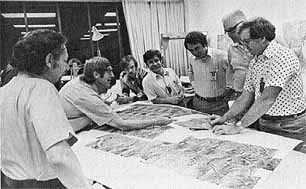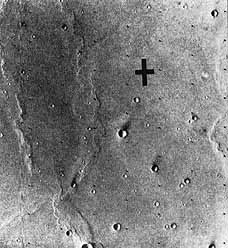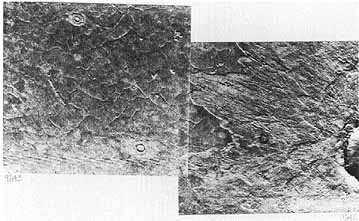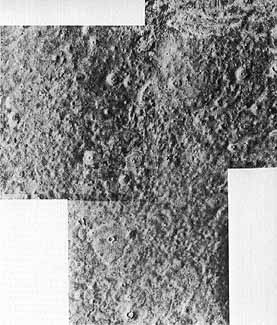















|
 | |
|
[347] Hal Masursky (above) on 12 July 1976 explains the geology apparent in the P22 photos. Jerry Soffen stands on his right. Across the mosaics, standing from right, are Tom Young, Jim Martin, Carl Sagan, Mike Carr, and an unidentified participant. Photo taken by Hans-Peter Bieman. Target for Viking 1 in Chryse Planitia at 22.4°N latitude, 47.5° longitude is shown in a photo taken 17 July. The area, photographed from 1551 kilometers away, is a smooth plain with many impact craters. |
 |

.....actuation commands from Earth, and some transient communications difficulties had to be corrected But most significant for the Landing Site Staff, the sampler arm on the lander had stuck on the third day of the landed mission (sol 3). Although the Viking team was able to diagnose the difficulty, devise and test a solution, and free the sampler boom assembly in time to collect soil samples on schedule (sol 8), the problem emphasized the importance of safely landing Viking 2 . Simply put, if Viking 1 failed, then no chances could be taken in choosing a landing site for the second mission. All the tension and pressure experienced during the past month reappeared. 57
|
B-3 East |
alpha |
47.2°N lat. |
224.9° long. |
|
B-3 East |
beta |
48.0°N |
228.0° |
|
B-2 West |
I |
44. 1°N |
154.9° |
|
B-2 West |
II |
47.3°N |
156.6° |
|
B-2 West |
III |
43.5°N |
153.0° 67 |

At 3:58:20 p.m. PDT (9:49:05 am. local Mars time) on 3 September 1976, the second lander touched down safely. Cheers mixed with sighs of relief, though the crisis was not over yet. The Deep Space Network worked with the flight team to get the proper commands to the orbiter. Once the spacecraft locked back onto its celestial reference point-the star Vega-Earth control again began to recover mission data, including the first two photographs taken by the lander's cameras immediately after the craft had reached the Martian surface. 71